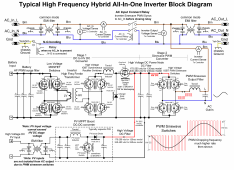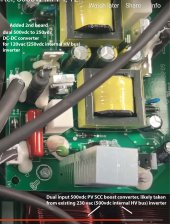Because of the non-isolated PV inputs from PWM AC chopper, there has been cases of accidentally allowing a PV line wire to momentarily touch ground and blowing out inverter sinewave PWM IGBT AC output power devices.
When HF inverter has its AC neutral grounded and AC inverter is active, the internal HV DC bus supply ground reference is chopped at AC line frequency between HV DC positive and negative sides of HV DC supply. When PV SCC controller is not electrically isolated its negative terminal will follow this HV DC ground reference switching. The PV electrolytic filter capacitors will cause positive terminal on PV to follow this chopping so both pos and neg lines on PV will ride on top of this HV DC ground reference polarity chopping.
Some HF inverters have an extra transformer coupled DC-DC converter between PV SCC output and inverter's HV DC supply. This extra DC-DC converter provides electrical isolation between inverter HV DC and PV inputs. It is usually done to allow maximum PV DC input voltage to be higher than inverter internal HV DC supply, typically so a 120vac inverter with 250v HV DC bus supply can allow PV inputs up to 500vdc. The extra DC-DC converter steps down SCC 500vdc output to inverter's 250vdc internal HV DC bus. Isolation is just a nice side benefit. Example of this extra DC-DC converter can be found on EG4 6500 EX-48 inverter. It has the extra DC-DC converter on top of 500vdc PV SCC PCB board for a 120 vac inverter to allow 500vdc max PV inputs.
View attachment 109203
Picture of EG4 6500 extra DC-DC converter in PV power path.
View attachment 109215




